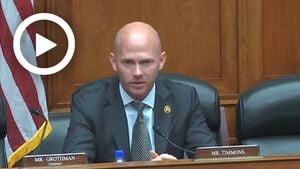President-elect Donald Trump returned to Washington, D.C., on November 13, 2024, entering the White House for the first time since being voted out of office, to meet with President Joe Biden. The historic meeting, initially marked with handshakes and smiles, served as both a symbolic gesture and practical discussion about the upcoming transition of power.
During their nearly two-hour encounter, the two leaders displayed cordiality, putting aside the acrimony of previous campaigns. Biden welcomed Trump back to the Oval Office, stating, “Congratulations, Donald, and welcome back.” The President emphasized the need for a “smooth transition,” assuring Trump his administration would facilitate all necessary arrangements for the incoming administration. "We’re going to get a chance to talk about some of what needs to happen today. Welcome. Welcome back to the Four Seasons of American politics,” he added.
Trump, who appeared pleased with the interaction, responded, “Politics is tough, and it’s often not the nicest world. But today’s different; it’s nice today. It’ll be as smooth as it can get, and I very much appreciate it, Joe.” This warm exchange was the first time Biden addressed Trump personally since the attempted assassination of the former president earlier this year. Their meeting came on the heels of Trump’s election victory over Democrat Kamala Harris, which has set the stage for his return to the White House.
The discussions covered not only arrangements for the transition but also pressing national issues, including the current geopolitical climate such as the conflicts involving Ukraine and the Middle East. Both leaders acknowledged their responsibility to prioritize the security of the nation, with Biden reportedly briefing Trump on issues involving U.S. hostages held by Hamas and the necessity of continuing support for Ukraine.
White House Press Secretary Karine Jean-Pierre described the meeting as "cordial" and "substantive," clarifying, "They discussed important national security and domestic policy issues facing the nation and the world." Trump arrived with specific inquiries, showcasing his readiness to engage with Biden on these pressing matters.
After stepping out of the Oval Office, Trump elaborated on their time together, emphasizing, “You know, it’s been a long slog. It’s been many hours and days and weeks, but I believe we managed to work through the tensions.” He appreciated Biden's willingness to facilitate this transition, remarking, “It’s been a lot of work on both sides, and he did an excellent job during the campaign and everything else. We really had a good meeting.”
Despite their greeting, the backdrop of Trump’s return is fraught with the political tensions and the controversial events of the previous administration. Trump, who is facing various legal challenges—including accusations of election tampering and other charges related to his presidency—has been largely embraced by the Republican base, who’ve rallied around his return.
The meeting served as more than just formalities; it underscored the reality of Trump’s continued influence over American politics and the divided sentiments surrounding him. Despite his past presidency being mired with contention, his supporters see his return as potential redemption and hope for addressing the nation's challenges, both domestically and internationally. The new Cabinet selections anticipated by Trump aim to reflect the administration he envisages as he prepares to take the oath of office once again.
Indeed, the backdrop has also sparked discussions about how the Biden administration will cope with Trump's policies amid divisive sentiments still prevalent since the last election. The meeting emphasized the fundamental principle of peaceful power transition, yet it couldn’t erase the complications inherent to their political history.
Biden's preoccupation with other pressing Congressional issues was also highlighted, as he mentioned to Trump potential legislation, including budgeting and disaster relief, conveying the need for collaboration, especially when facing stern criticisms from Republican lawmakers seeking to challenge Democratic spending priorities.
While the proceedings at the White House showed outer tranquility, discussions about Trump's past remain swirling. His controversial presidency left wounds which some would argue require healing, as Democrats try to navigate how to manage the Trump era's echoes moving forward. Biden has often referred to Trump with derision, expressing his aversion to Trump’s actions and the challenge of bipartisan relationships during their earlier confrontations.
This meeting symbolizes not just the return of Trump but perhaps the normalization of his political demeanor, as both leaders must confront the reality of governance necessitating collaborative engagement, regardless of personal discomfort. It will remain to be seen how their relationship evolves as they handle the pressures surrounding the impending handover.
Interestingly, this transitional period does not come without challenge; prior to this meeting, Trump's team has faced criticism for not efficiently completing transitional paperwork—a situation reminiscent of the tumultuous transition back in 2020. Experts note the struggle Biden's team faced during Trump's administration as they were initially stonewalled on numerous fronts.
Back then, Trump had refused to acknowledge his electoral loss to Biden, resulting in significant delays during the transition and creating clashes between the two parties. The lessons learned from this apprehension resonate with the necessity to have clear communication lines open between the outgoing and incoming administrations, to prevent derailment of strategic national efforts.
Looking forward, both administrations must tread carefully with appreciation of each other's role—an increasingly challenging endeavor within the hyperpartisan atmosphere defining contemporary politics. This initial meeting might be merely the tip of the iceberg as the nation braces for what will undoubtedly be momentous weeks leading up to the January inauguration.
Trump, recalling the gleaming Oval Office, characterized his previous administration fondly, affirming, "I love the Oval Office. It’s beautiful. It’s where I put my blood, sweat, and tears for the American people.” The nostalgia might have tempered his remarks about the hostile political climate as both men signaled intent to collaborate for the good of their country, emphasizing unity over division.
While some citizens express hope for compromise, others remain deeply skeptical, pointing out the seemingly insurmountable differences stemming from Trump's controversial past and the ideological rift it has created. The atmosphere leading up to his new presidency could potentially test the boundaries of bipartisanship for both party leaders as they confront issues towering over them.



